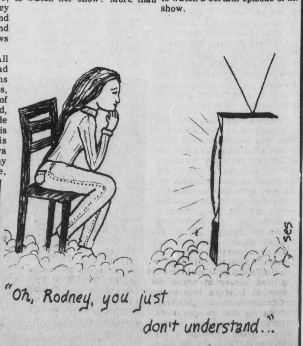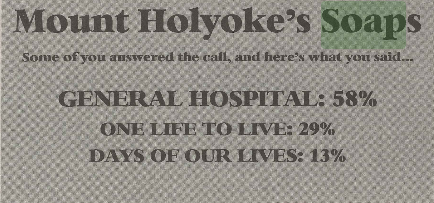BY EMILY BERNSTEIN ’18
On Feb. 28, 1980, members of the Mount Holyoke Campus Social Committee wrote an Op-Ed lamenting the “MHC social disease.” This referred to the students’ tendency to complain relentlessly about their social lives while doing nothing to amend the situation. The Committee ruthlessly posited that the typical Mount Holyoke student’s daily schedule consisted of the following:
9:00-10:00 Breakfast and light chit-chat
10:00-12:15 Classes
12:15-1:00 Lunch - General discussion
1:00-2:00 All My Children
2:00-3:00 One Life to Live
3:00-4:00 General Hospital
4:00-6:00 A spot of work and some invigorating conversation
6:00-7:00 Din-din
7:00-8:00 Talking about work
8:00-10:00 Reading Sweet Savage Love
10:00-10:30 M & C’s (moaning about work)
10:30-11:45 Shower and bedtime B.S.
12:00-9:00 Sleep (dream about work)
The following week, in a letter to the editor, Catherine Dreiss ’83 and Elizabeth Cousins ’82 objected most strongly to this generalization, writing that “Contrary to the Social Committee’s portrait of the typical Mount Holyoke student, we do not watch soap operas (classes 9 to 4 are a hindrance)...The Social Committee’s attitude that the student body should take what they give it, and be grateful, is the source of the problem.”
While they may have been right — perhaps the Committee was at fault for a lackluster social life on campus — Dreiss and Cousins were certainly wrong about on-campus consumption of soap operas.
Jody Meth ’80 wrote that “If you go into the TV room of any dorm between the hours of 12:30 and 1:30, you’re likely to see as many as fifteen people huddled around the TV, intent on the soaps” in a Feb. 1977 article titled “Soap operas fill ‘Days of Our Lives.’” Watching the soaps was an unofficial community event, and people participated regularly — many dorms had a preferred program. North Mandelle residents were drawn to “All My Children” and “Ryan’s Hope,” Mead-dwellers chose “Days of Our Lives,” and the favorite in Prospect was “Another World.”
The soaps were so popular that more than half of those Meth interviewed confessed to skipping class in order to watch their chosen soap at least once. About a quarter of them admitted that they planned their course schedules around their favorite programs.
Betsy Mullins ’90 covered an April 1989 “Faculty Know Show” which parodied Mount Holyoke life. During the performance, a “student complainer” worried that her lab time overlapped with the time her soap operas were on — indicating that not much had changed since 1977.
Even as the computer age began, soap operas remained a mainstay of procrastination tactics on campus. In Dec. 1996, the Mount Holyoke News featured a soap opera gossip website in its weekly “site bytes” feature. The paper recommended it as a way to stay up-to-date with favorite shows while staying on track with their academic responsibilities.
A few years later in March 1999, the Mount Holyoke News polled students to find out which soap opera they preferred. 58 percent chose “General Hospital,” while “One Life to Live” and “Days of Our Lives” received only 29 and 13 percent of votes, respectively. Soap operas were not yet a thing of the past.
18 years later, many current students consider soap operas obsolete, but they’ll still huddle around the TV to watch reality shows, major sports events or awards shows.Last February, Jenna Centofanti ’18 told sports editor Caitlin Lynch ’20 that she had attended a Super Bowl viewing party, and saw the Patriots’ astounding comeback and victory with friends.
Perhaps the era of soap operas has truly passed for Mount Holyoke students, but the tradition of watching TV together has not. Whether it’s the Kardashians, the Bachelor or the Oscars, you can still find MoHos clustered in common spaces, with their eyes glued to a screen.
MHN 100 is a bi-weekly column celebrating the newspaper’s 100 years of student journalism. Archival copies of the Mount Holyoke News can be found at compass.fivecolleges.edu.



